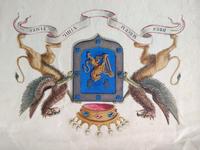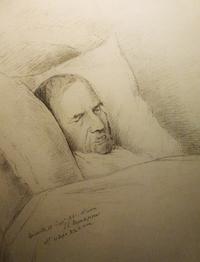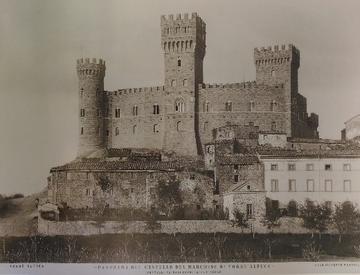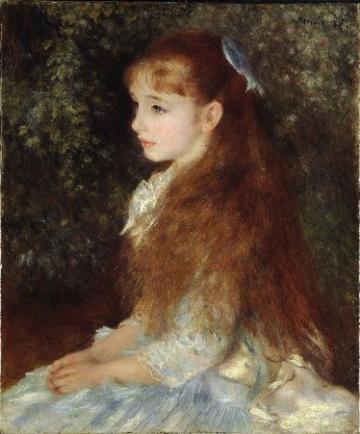The Cahen D'Anvers in France and Italy
A family's history between art and politics

Luigi Paoletti, Sketch for Meyer Joseph Cahen d’Anvers’ coat of arms, 1865, mixed technique on paper, Rome, Archivio Centrale dello Stato, Consulta araldica, b.3, n.27.
Les Cahen d’Anvers en France et en Italie is about people, art and society. It deals with the story of an Ashkenazi Jewish banker born in Bonn in 1804, and his descendants. Through the study of twelve houses and their collections, it tells the story of a dynasty of entrepreneurs who, from the former Ghetto of Bonn – 821 Rue des Juifs – joined the highest level of European society, especially in Paris and Rome. Published by LGDJ, thanks to the Louis Joinet Doctoral Prize, this book marks the achievement of five years of research, which was warmly sustained by the Jewish Country Houses Project’s team. Working on the history of Jewish communities in France and Italy, within the broader cultural history, this study allowed me to analyze and narrate the challenges that the Cahen family faced during their time.

Édouard Levi Montefiore, Mayer Joseph Cahen d’Anvers on his deathbed, 1881, ink on paper, Montréal, private collection.
Founding member of a banking network related to the modern-day BNP Paribas Group, Meyer Joseph Cahen (1804-1881), adopted the “d’Anvers” when he settled in Paris in 1849. Born in Bonn, of a family of Jewish merchants, he made his fortune in the Belgian city to which he associated his name, and he continued his career in France. Owner of Nainville’s castle (France, Essonne) and of the Petit Hôtel de Villars (Paris), he became a naturalized French citizen in 1865. The next year, he obtained the title of Count, bestowed upon him by the King of Italy Victor-Emmanuel II, thanks to the economic support offered by the Cahen d’Anvers to the Italian Unification. Nineteen years later, King Humbert I of Italy surpassed his predecessor and raised Meyer Joseph’s eldest son, Édouard (1832-1894), to the status of Marquis of Torre Alfina.
If his siblings – Emma (1833-1901), Louis (1837-1922), Raphaël (1841-1900) and Albert (1846-1903) – enrooted their paths in the French capital, the eldest lived between Florence, Naples and Rome: he was one of the great investors involved in the urban renovation of the Italian capital, after the fall of the papacy.
In Italy, as well as in France, art, and especially architecture, served to legitimize the recent nobility of a 19th century family that wished to express the fullness of its civil rights. At the time of the Dreyfus Affair, the Cahen d’Anvers adopted what could be defined as a “top-down model of integration” – wealth and social influence were a natural instrument to assert a place into the mainstream society. My research focuses on cultural integration mechanisms, development, and controversy. After tracing the patriarch’s origins, I analyzed the family’s matrimonial policies, and explored the Cahen d’Anvers’ taste in the vast field of art, music, and literature.

Fratelli Alinari, Torre Alfina castle, 1890 ca., Acquapendente, private collection
From the 1840s to the beginning of the 20th century, twelve mansions offered a perfect stage for the Cahen d’Anvers’ social gatherings. As a public manifestation of the family’s economic and social power, the historicist eclecticism of these properties aimed to represent the owners as a new phalanx of the old nobility. While Forge-Philippe’s manor (Belgium, Wallonia), Gérardmer’s chalet (France, Vosges) and Villa della Selva (Italy, Umbria) expressed a certain openness to 20th century novelties, the three residences rented by the family (Hôtel du Plessis-Bellière, Paris; Palazzo Núñez-Torlonia, Rome; Château de la Jonchère, France, Yvelines) and the two properties of Meyer Joseph (Nainville castle and the Petit Hôtel de Villars) dressed up their nineteenth century spaces with Ancien Régime motifs. This could also be seen in the Cahen d’Anvers’ palace in Rue de Bassano (Paris), or the castles of Champs (France, Seine-et-Marne), Bergeries (France, Essonne) and Torre Alfina (Italy, Latium). Thanks to their historical knowledge and taste, the architects Destailleur,Giuseppe Partini and Eugène Ricard, as well as the landscapers Henri and Achille Duchêne, were able to shape the Middle Age, the Renaissance and the 18th century’s “grammars” to their patrons’ taste and ambitions.
Moreover, to investigate Édouard Cahen d’Anvers’ activity in Rome allowed me to better understand the development of 19th century urban plans in the Vatican area, in Prati di Castello. Working on Édouard’s relationship with the prelate François Xavier de Mérode (1820-1874) two interesting inventories came out. They describe the Renaissance villa of Bindo Altoviti (1491-1557), which was demolished in the 1880s. Together with Giorgio Vasari’s frescoes, and its gardens, Villa Altoviti is the subject of a forthcoming monograph co-authored with Alessandro Cremona (La Villa Altoviti ai Prati di Castello. Eclissi di un paesaggio fluviale, Officina Libraria, 2023-2024).

Pierre-Auguste Renoir, Portrait of Irène Cahen d’Anvers, 1880, oil on canvas, Zurich, Fondation E.G. Bührle
In Rome and Paris, Guy de Maupassant, Paul Bourget, Marcel Proust, and Gabriele D’Annunzio, along with painters Federico de Madrazo, Carolus-Duran, and Léon Bonnat, were among the notable figures who frequented the Cahen d’Anvers’ salons. In rue de Bassano’s palace, one of the family's most notable and controversial possessions was the Petite fille au ruban bleu, a portrait of Irène Cahen d’Anvers, painted by Pierre-Auguste Renoir, and currently held by the Bührle Foundation in Zurich. In the book, this item, as the rest of the family’s collections, is studied in detail. The biographies of Louise and Hugo Cahen d’Anvers, also available on the database “Collectionneurs, collecteurs et marchands d'art asiatique en France 1700-1939”, offer an in-depth look at the family’s Asian collections. The relation between the family and the Pre-Raphaelite Brotherhood is investigated through the biography of Christina Spartali (1846-1884) – Edouard Cahen d’Anvers’ wife – who served as model for The Princess from the Land of Porcelain by James McNeill Whistler (Washington, Freer Gallery of Art). The family’s patronage in the music field is analysed through the biographies of the composer Albert Cahen d’Anvers and his nephew Rodolfo.
The Jewish Country Houses conferences at the University of Oxford (March 2018) and Villa Kerylos (May 2019), as well as the Jewish Collectors and Patterns of Taste conference in Paris (June 2022), offered an important contribution to my research, creating a fertile ground for academic exchanges. In a similar way, the forthcoming book Jewish Country Houses, edited by Juliet Carey and Abigail Green, allowed me to work in contact with other international scholars, comparing the Cahen d’Anvers’ choices to those of the Rothschild, Montefiore, Stern, etc.
As Jews, targets of the anti-Semitic press and members of the financial elite, the Cahen d’Anvers family experienced the consequences of the Dreyfus Affair. The third generation suffered the horrors of the racial laws. With a long excursus on the Second World war, I wished to shed light on the family destiny and their engagement in the French Resistance. The forthcoming publication of the war journals of Renée and Colette Cahen d’Anvers will allow me to go deeper in the subject, sharing with the readers the intimate stories of two women fighting for freedom and equality.
Focusing on the 19th century, with a multidisciplinary and transnational approach, the book Les Cahen d’Anvers en France et en Italie wishes to dismantle the stereotypes of the «Jewish chimera» built by the antisemitic pamphleteer Édouard Drumont (1844-1917). Brought to the attention of the Research Network on Racism and Antisemitism (RRA), this work aims to analyses the history of one of these great Jewish families who, as transnational elements, gave an important contribution to the definition of the democratic identity of Europe. With almost 500 images and an index of names with over 1.000 references, the volume intertwines Art History and Jewish Studies, tracing the history of the Cahen d’Anvers family, its mansions and collections, through two centuries, two countries and three generations.
Les Cahen d’Anvers en France et en Italie. Demeures et choix culturels d’une lignée d’entrepreneurs (by Alice S. Legé, LGDJ – Institut Louis Joinet, 2022) is available to order from all usual book retailers, or from https://www.lgdj.fr/.


